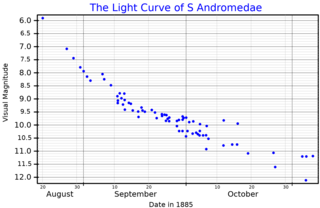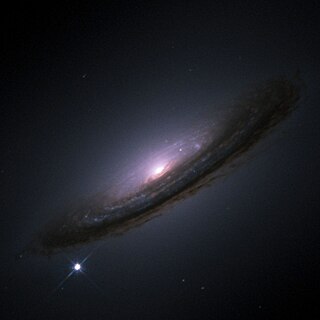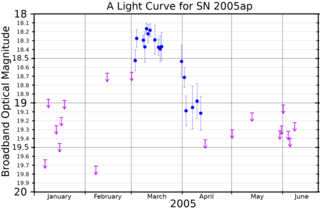
SN 1885A was a supernova in the Andromeda Galaxy, the only one seen in that galaxy so far by astronomers. It was the first supernova ever seen outside the Milky Way, though it was not appreciated at the time how far away it was. It is also known as "Supernova 1885".

SN 2005bc was a Type Ia supernova occurring in the barred spiral galaxy NGC 5698, located in the northern constellation of Boötes. SN 2005bc was discovered on 2 April 2005 by LOSS and independently by Tim Puckett and L. Cox. It was positioned at an offset of 4.6″ east and 7.5″ north of the galactic nucleus. The supernova was at magnitude 16.4 at discovery, and quickly rose to a peak magnitude of around 15.3 just over a week after discovery. It showed an expansion velocity of 12,000 km/s. By mid-May, the supernova had faded to 17th magnitude.

A Type Ia supernova is a type of supernova that occurs in binary systems in which one of the stars is a white dwarf. The other star can be anything from a giant star to an even smaller white dwarf.

SN 1994D was a Type Ia supernova event in the outskirts of galaxy NGC 4526. It was offset by 9.0″ west and 7.8″ south of the galaxy center and positioned near a prominent dust lane. It was caused by the explosion of a white dwarf star composed of carbon and oxygen. This event was discovered on March 7, 1994 by R. R. Treffers and associates using the automated 30-inch telescope at Leuschner Observatory. It reached peak visual brightness two weeks later on March 22. Modelling of the light curve indicates the explosion would have been visible around March 3-4. A possible detection of helium in the spectrum was made by W. P. S. Meikle and associates in 1996. A mass of 0.014 to 0.03 M☉ in helium would be needed to produce this feature.

SN 2003fg, nicknamed the Champagne Supernova, was an unusual Type Ia supernova. It was discovered in 2003, with the Canada-France-Hawaii Telescope and the Keck Telescope, both on Mauna Kea in Hawaii, and announced by researchers at the University of Toronto. The supernova occurred in a galaxy some 4 billion light-years from Earth. It was nicknamed after the 1995 song "Champagne Supernova" by English rock band Oasis.

Type Ib and Type Ic supernovae are categories of supernovae that are caused by the stellar core collapse of massive stars. These stars have shed or been stripped of their outer envelope of hydrogen, and, when compared to the spectrum of Type Ia supernovae, they lack the absorption line of silicon. Compared to Type Ib, Type Ic supernovae are hypothesized to have lost more of their initial envelope, including most of their helium. The two types are usually referred to as stripped core-collapse supernovae.

A Type II supernova or SNII results from the rapid collapse and violent explosion of a massive star. A star must have at least eight times, but no more than 40 to 50 times, the mass of the Sun (M☉) to undergo this type of explosion. Type II supernovae are distinguished from other types of supernovae by the presence of hydrogen in their spectra. They are usually observed in the spiral arms of galaxies and in H II regions, but not in elliptical galaxies; those are generally composed of older, low-mass stars, with few of the young, very massive stars necessary to cause a supernova.

SN 2006gy was an extremely energetic supernova, also referred to as a hypernova, that was discovered on September 18, 2006. It was first observed by Robert Quimby and P. Mondol, and then studied by several teams of astronomers using facilities that included the Chandra, Lick, and Keck Observatories. In May 2007, NASA and several of the astronomers announced the first detailed analyses of the supernova, describing it as the "brightest stellar explosion ever recorded". In October 2007, Quimby announced that SN 2005ap had broken SN 2006gy's record as the brightest-ever recorded supernova, and several subsequent discoveries are brighter still. Time magazine listed the discovery of SN 2006gy as third in its Top 10 Scientific Discoveries for 2007.

SN 2005ap was an extremely energetic type Ic supernova in the galaxy SDSS J130115.12+274327.5. With a peak absolute magnitude of around −22.7, it is the second-brightest superluminous supernova yet recorded, twice as bright as the previous record holder, SN 2006gy, though SN 2005ap was eventually surpassed by ASASSN-15lh. It was initially classified as type II-L, but later revised to type Ic. It was discovered on 3 March 2005, on unfiltered optical images taken with the 0.45 m ROTSE-IIIb telescope, which is located at the McDonald Observatory in West Texas, by Robert Quimby, as part of the Texas Supernova Search that also discovered SN 2006gy. Although it was discovered before SN 2006gy, it was not recognized as being brighter until October 2007. As it occurred 4.7 billion light years from Earth, it was not visible to the naked eye.

SN 1979C was a supernova about 50 million light-years away in Messier 100, a spiral galaxy in the constellation Coma Berenices. The Type II supernova was discovered April 19, 1979 by Gus Johnson, a school teacher and amateur astronomer. This type of supernova is known as a core collapse and is the result of the internal collapse and violent explosion of a large star. A star must have at least 9 times the mass of the Sun in order to undergo this type of collapse. The star that resulted in this supernova was estimated to be in the range of 20 solar masses.

SN 1993J is a supernova observed in Bode's Galaxy. It was discovered on 28 March 1993 by F. Garcia in Spain. At the time, it was the second-brightest type II supernova observed in the twentieth century behind SN 1987A, peaking at a visible apparent magnitude of 10.7 on March 30, with a second peak of 10.86 on April 18.

SN 2003gd was a Type II-P supernova explosion in the Phantom Galaxy, located in the constellation Pisces. SN 2003gd was discovered on 12 June 2003 by Robert Evans, using a 0.31m reflector, and its discovery was confirmed on 13 June 2003 by R. H. McNaught using the 1.0m telescope at the Siding Spring Observatory.
SN 2005gj was a supernova located approximately 864 million light years away from Earth. It was discovered on September 27, 2005, by the Sloan Digital Sky Survey and the Nearby Supernova Factory. 2005gj was noted because it had qualities of both type Ia and type IIn supernovae, and because hydrogen emission lines were found in its spectrum. These hydrogen lines, which were found on the spectrum at redshift z=0.0613, are thought to be indicative of interactions with a circumstellar medium by the supernova's ejected matter or white dwarf progenitor. Such emission lines are extremely rare in Type Ia supernovae – only one other Type Ia, SN 2002ic, has been observed to exhibit the same properties. However, 2005gj's CSM interaction was much stronger and more clearly observed than 2002ic's. The mass-loss history 2005gj's hydrogen lines suggest has been cited as evidence that luminous blue variable (LBV) hypergiants can be progenitors of thermonuclear supernovae.
SN 2002cx is a peculiar type Ia supernova. It was discovered in May 2002 by a team of researchers from LBL. It behaved differently from normal type Ia supernovae, and differently from several other previously observed peculiar type Ia supernovae including SN 1991T and SN 1991bg.
SN 2005E was a calcium-rich supernova first observed in January 2005 that scientists concluded was a new type of cosmic explosion. The explosion originated in the galaxy NGC 1032, approximately 100 million light years away.

SN 1994I is a Type Ic supernova discovered on April 2, 1994 in the Whirlpool Galaxy by amateur astronomers Tim Puckett and Jerry Armstrong of the Atlanta Astronomy Club. Type Ic supernova are a rare type of supernova that result from the explosion of a very massive star that has shed its outer layers of hydrogen and helium. The explosion results in a highly luminous burst of radiation that then dims over the course of weeks or months. SN 1994I was a relatively nearby supernova, and provided an important addition to the then small collection of known Type Ic supernova. Very early images were captured of SN 1994I, as two high school students in Oil City, Pennsylvania serendipitously took images of the Whirlpool Galaxy using the 30-inch telescope at Leuschner Observatory on March 31, 1994, which included SN 1994I just after it began to brighten.
SN 1961i was a supernova that was discovered in June 1961 in the Messier 61 galaxy, by Milton L. Humason at the Palomar Observatory, the brightest of 16 supernovae found at Palomar that year. Although it was originally considered by Fritz Zwicky to be the prototype of a type III supernova, subsequent researchers have classified it as a type II supernova.
iPTF14atg is a type-Ia supernova discovered on 3 May 2015. The supernova is located in galaxy IC 831, some 300 Mly (92 Mpc) distant. The supernova is thought to have ignited on May 2 or 3. The supernova's shockwave slammed into a companion star, shocking it into producing an ultraviolet pulse. The companion star that was hit is suspected to be a red giant star. This detection of the UV signal represents the first time the collision event of a supernova shockwave upon a companion star has been detected. The supernova was discovered by the Intermediate Palomar Transient Factory (iPTF), a successor to the earlier Palomar Transient Factory, and based at the Palomar Observatory in California. The data was processed by collaborators in Europe, that lead to the supernova discovery.
SN 2013fs is a supernova, located in the spiral galaxy NGC 7610, discovered by the Intermediate Palomar Transient Factory sky survey at Palomar Observatory in October 2013. It was discovered approximately three hours from explosion and was observed in ultraviolet and X-ray wavelengths, among others, within several hours. Optical spectra were obtained beginning at six hours from explosion, making these the earliest such detailed observations ever made of a supernova.
SN 2013ej is a Type II-P supernova in the nearby spiral galaxy Messier 74. It was discovered by the Lick Observatory Supernova Search on July 25, 2013, with the 0.76 m Katzman Automatic Imaging Telescope, with pre-discovery images having been taken the day before.











